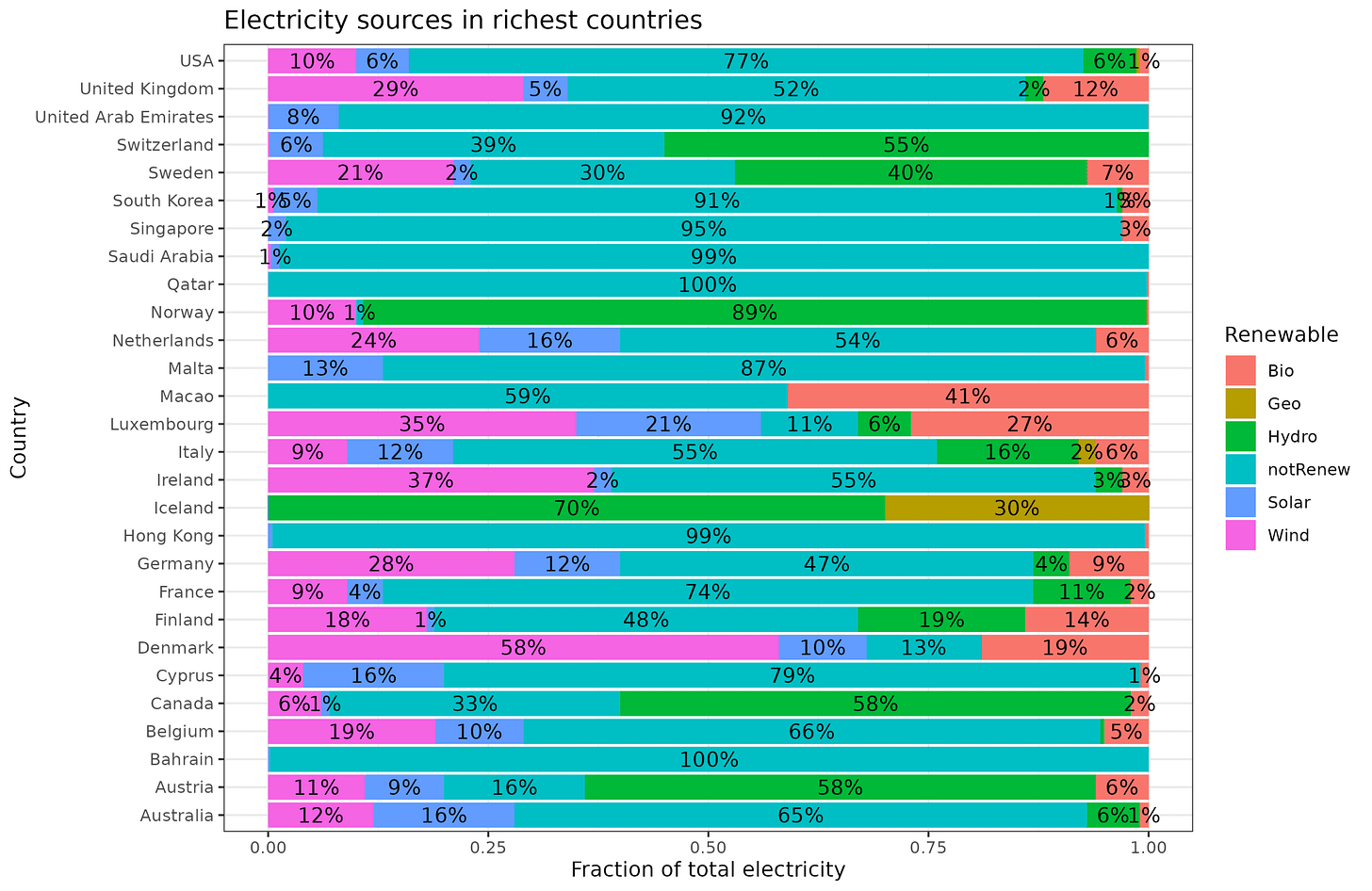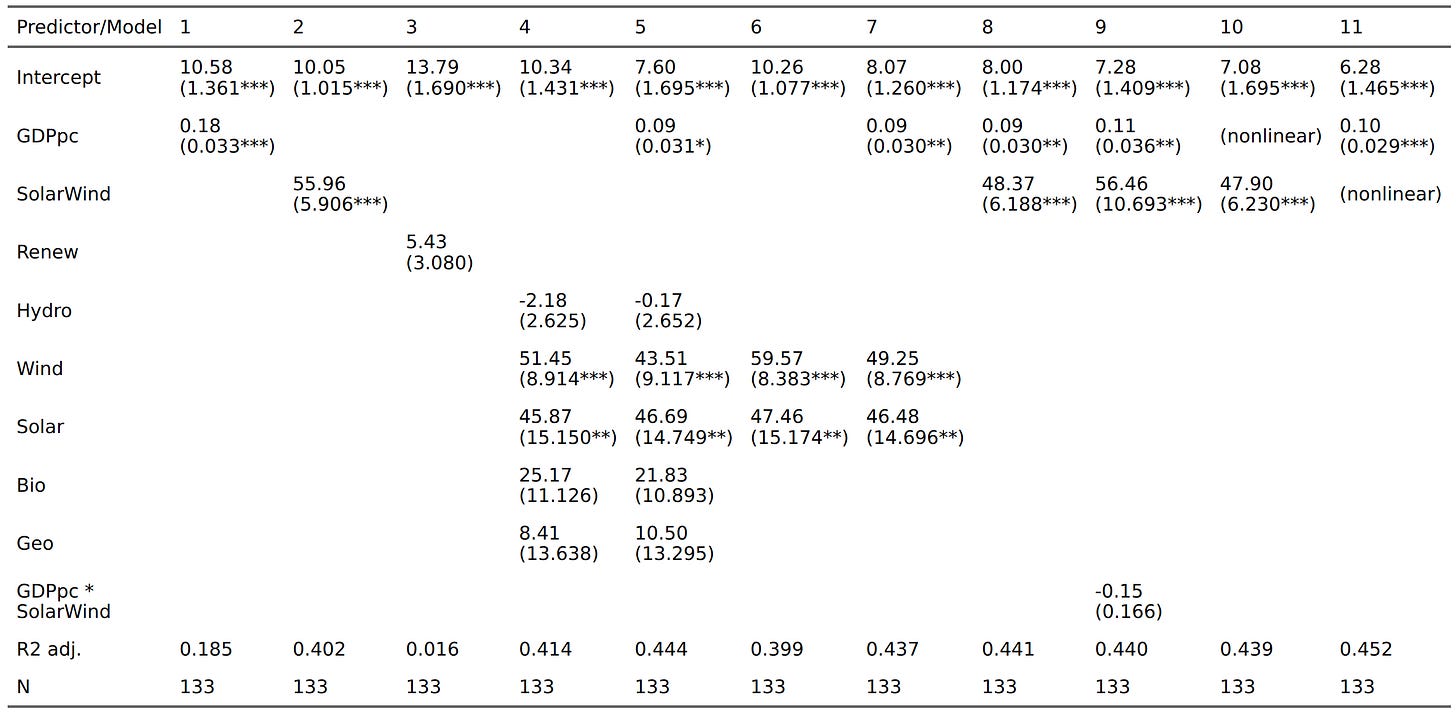Solar and wind are very expensive
Regression analysis of 133 countries' production and prices
Danish cheaper energy activist Bjørn Lomborg posted this on X:
The obvious problem here is that maybe electricity prices just reflect prices overall (presumably because electricity generation in part costs human labor which scale with the economy). For this reason, we need to include some kind of measure of wealth as a control. So let's do that. I downloaded some data for electricity prices from here, and electricity source distribution from Wikipedia. The source distribution for countries with GDPpc > 50k are:
So among wealthy countries, there is a reasonable mixture that we can statistically exploit. Here's the two obvious models we can start with:
Solar+Wind% predicts prices a bit better than GDPpc. However, we can go further. Let's not assume that solar and wind are the key sources to focus on or that they should be aggregated, but look at all of them:
The models are:
GDPpc (in thousands), can explain a good chunk of price variation. Increasing GDPpc by 1000 means an expected price increase of 18 US cents/kw.
SolarWind does much better. SolarWind is a fraction, so going from 0% to 100% means expected price increase of 56 US cents/kw.
Renewables% taken together does not predict anything (hydro seems cheap, predicted cost is negative!).
Using the specific renewable types does not explain much more than solar+wind alone (compare R2 to model 2).
Adding GDPpc to renewable types helps explain a little bit, about 3%point added R2.
Splitting up solar and wind doesn't matter compared to using them as a single variable (compare to model 2).
And this is also true if we add GDPpc.
Having GDPpc and solar+wind together shows that solar+wind mostly retains its effect (56 to 48) while GDPpc is halved (0.18 to 0.09).
There isn't any interaction between the two variables either. Surprising to me.
No nonlinear effect of GDPpc.
Nor of solar+wind (no benefits of scale).
I also tried some other things not included above:
Log10 GDPpc (much worse than raw).
GDP per worker (slightly higher validity but harder to interpret).
Nonlinear interactions.
The above numbers are in raw units, but what is the relative importance? The standardized betas tell us this, roughly, and they are:
Thus, looking at the standardized units, we see that solar+wind is about 2.5x as important GDPpc in explaining electricity prices. That was unexpected. In fact, we can look at my home country of Denmark. Denmark is uniquely stupid because not only do we have 0% nuclear power (it is illegal to produce!), but we have also embraced wind power in the extreme, 58% wind power generation, the largest among rich countries. According to our model, then, how would electricity prices be in Denmark if we set wind+solar to 0% or 100%?
Current price: 48 US cent/kwh
Set to 0% solar+wind: 15 US cent/kwh
Set to 100% solar+wind: 63 US cent/kwh.
Thus, prices are expected to change roughly by a factor of (4.3). Or put another way, electricity costs about 330% more than what it would otherwise cost. Regarding that, we can also look at the model predictions from model 8:
This also shows how GDPpc explain a relatively small part of the price differences. Maybe this means we need a better economic measure. I leave it to the readers to decide on which one to try and post their own results. My data are here, and code is here.
Some academics and their journalist friends have been claiming in recent years that solar+wind has finally become price competitive (the decline in new solar panels is very impressive and important). It's hard to believe based on these data, but maybe this is a lagging indicator. Furthermore, since electricity can be imported, if you are lucky to have a neighbor who sells cheap electricity, you could have very low prices despite having your production be expensive solar+wind (you would simply scale down your own production). In practice, however, electricity cannot so easily be transferred as there is a transport loss with distance, so realistically, one can only buy from relatively nearby countries. Furthermore, the electricity cables have limits, thus limiting how much one can buy from such a potential nice neighbor. It would be difficult but possible to include some kind of measure of availability of cheaper electricity from neighbors (maybe spatial lag would be sufficient). Case in point, Norwegian politicians were discussing stopping the sale to Denmark (not reviewing the cable agreements) due to very bad European prices. Finally, it should be mentioned that the carbon footprint of energy production does not solely reflect the country's own production, but also their neighbors. This is because they import electricity from countries whose composition of energy sources may differ. Because of this, Denmark is not as CO2 neutral as the Danes are paying for. If one wanted to go deeper into proving the causality here, one should see if one can get time series data for both the electricity source composition and the prices. This would enable one to show that holding country level factors constant, the changes in composition still predict price changes. The poor man's version of this would be to use spatial lags to control for unobserved variables, which would also capture some of the electricity trading. Overall, though, it seems Bjørn Lomborg is right about the wind+solar energy costs. They are sky-high and turbulent.








It seems like there is relatively little discussion of biomass(specificially within the context of burning wood to generate electricity).
In the US the states with over 50-60% of there electricity from wind still have some of the lowest electricity rates for both industrial and household use.
It is true that renewables need more batteries and transmission to even things out, but they also have less price variability than gas (2022 spike). New renewables have cheaper cost profiles than older version of the tech, to such a degree that there are solid papers arguing that solar may be the cheapest energy source in basically every country by 2030.
I wonder how this analysis would look looking at the US for wind penetration. Production is actually often a much smaller part of rates than transmission, meaning that the differences between natural gas and wind are less salient than the delivery and subsidy to biomass.
If wind were truly a more expensive technology than everything else why would countries pick it? Also this ignores taller turbines driving prices down a lot (more swept area of turbines and winds are more consistent as well as faster in taller spots)
https://en.wikipedia.org/wiki/Wind_power_in_Iowa#Wind_generation
https://www.eia.gov/state/?sid=IA#tabs-5 (electricity and prices tab)
Claims that renewables are becoming cost-competititve with fossil fuels rely on levelised costs, which ignore the costs that renewables impose on the system
as a whole. That's why such claims are at odds with the regression analysis you have performed.